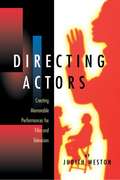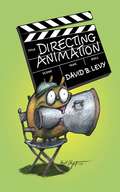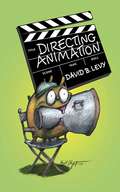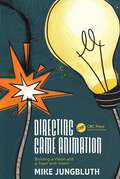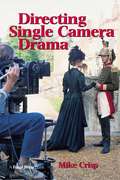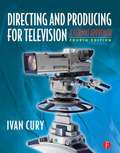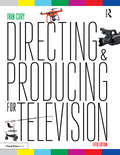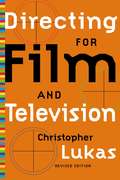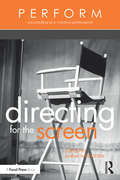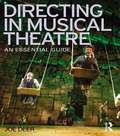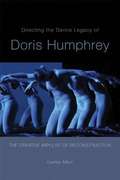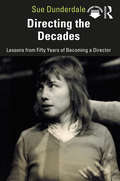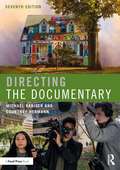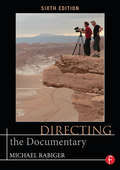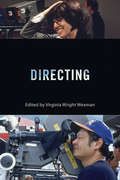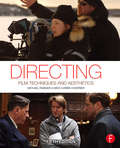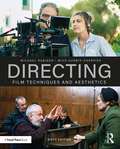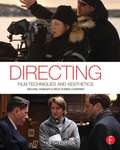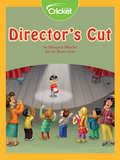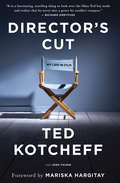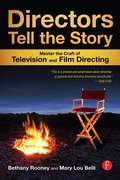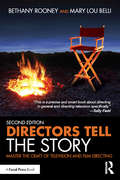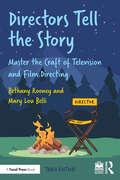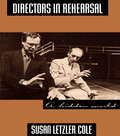- Table View
- List View
Directing Actors: Creating Memorable Performances for Film and Television
by Judith WestonInternationally-renowned directing coach Weston demonstrates what constitutes a good performance, what actors want from a director, what directors do wrong, script analysis and preparation, how actors work, and shares insights into the director/actor relationship.
Directing Animation
by David B. LevyBoth experienced and aspiring animation professionals will find Directing Animation a comprehensive and entertaining guide to understanding the director's creative role in managing the entire animation process. An animation director doesn't simply direct animation. He or she directs people who animate and must be equally able to relate to the crew, producers, writers, creators, and clients. Readers will learn how to: -- direct commercials, TV series, feature films, and Web features and series -- land their first big directorial break -- create realistic schedules and pipelines -- assemble the best crew for any job -- motivate animators and crew members -- give constructive feedback and notes -- maintain good relationships with producers, creators, writers, and network executives. In addition to over eighty photographs and illustrations, Directing Animation includes insider tips and firsthand experience from animators, directors, and producers, revealing the best ways to manage the production process while creating a workplace that is both efficient and fun.
Directing Animation
by David B. LevyBoth experienced and aspiring animation professionals will find Directing Animation a comprehensive and entertaining guide to understanding the director's creative role in managing the entire animation process. An animation director doesn't simply direct animation. He or she directs people who animate and must be equally able to relate to the crew, producers, writers, creators, and clients. Readers will learn how to: -- direct commercials, TV series, feature films, and Web features and series -- land their first big directorial break -- create realistic schedules and pipelines -- assemble the best crew for any job -- motivate animators and crew members -- give constructive feedback and notes -- maintain good relationships with producers, creators, writers, and network executives. In addition to over eighty photographs and illustrations, Directing Animation includes insider tips and firsthand experience from animators, directors, and producers, revealing the best ways to manage the production process while creating a workplace that is both efficient and fun.
Directing Game Animation: Building a Vision and a Team with Intent
by Mike JungbluthThe best character animation has a strong creative intent, driving a compelling performance. With the addition of interactivity, game animation adds complexity to the craft of how best to balance art, design and technology to realize a character’s performance. As a director, you are responsible for not only defining a vision for how those should balance but also being a leader, mentor and advocate for your team. But in a field of rapid iteration of ideas and techniques, that strong creative intent can be easily lost or sacrificed if not properly fostered and defined.Directing Game Animation: Building a Vision and a Team with Intent breaks down the process of creating an intentional animation vision that can be both unique and flexible. From defining the high-level experience to breaking down tech needs, projecting a team size and empowering everyone to work together, this book will help you to wrap your mind around a project’s animation needs.Animation, like every part of a game, cannot succeed—let alone function—in a vacuum. This book looks to foster a discussion around the process, needs and benefits of an empowered animation team and its vision as a universal benefit for the entire industry.This book is a guide to answer some of the most common questions people encounter when engaging with the overlap between creative and project leadership. What is your role? Learn how to establish expectations and needs specific to the project and team. How do you establish a vision? Learn how to better define and communicate creative topics such as a cohesive character performance and animation style. How do you build a team? Learn how to establish early on the team structure, skills and workflows needed to deliver on the needs of the project. How do you balance creative and production needs? Learn how to define quality, reviews and approvals in a way that empowers creativity and decision-making.
Directing Single Camera Drama
by Mike CrispDirecting drama for the single camera is like no other form of Filmmaking, or any other medium involving actors. Experience in documentary or theatre may provide useful clues, but the techniques for drama film directors, although not basically complicated, are unique. Experienced directors in other spheres of directing will find this book invaluable if they wish to move into single camera drama, as will students setting out on their careers. Directing Single Camera Drama is a synthesis of the skills required to bring drama to the screen. Directing drama for the single camera is like no other form of Filmmaking, or any other medium involving actors. Experience in documentary or theatre may provide useful clues, but the techniques for drama film directors, although not basically complicated, are unique. Experienced directors in other spheres of directing will find this book invaluable if they wish to move into single camera drama, as will students setting out on their careers. Directing Single Camera Drama is a synthesis of the skills required to bring drama to the screen.A unique feature of the book is the inclusion of ten short film drama scripts which need only half a day's rehearsal and one short day's filming. Each have their various technical demands, and they are arranged in ascending order of dramatic and creative difficulty. They can be photocopied and used for non-broadcast training drama exercises. Mike Crisp worked as Production Manager, and later Director, on many classic BBC TV series, such as Fawlty Towers, Porridge and Steptoe and Son. He was, for 10 years, a senior producer with the BBC's TV Training Department. He is the author of The Practical Director now in its second edition and also published by Focal Press.Reviews:'Directors in other spheres of directing who wish to move into single camera drama will find this book invaluable, as will students setting out on their careers.'Voice of the Listener
Directing and Producing for Television
by Ivan CuryDirecting and Producing for Television provides you with the tools you'll need to direct and produce effectively in a variety of settings. Based on his years of experience in the industry and teaching the subject, Cury illustrates fundamental principles with engaging anecdotes that teach by example.Ideal for students in television production courses as well as industry professionals, Directing and Producing for Television addresses critical production techniques for various formats including panel programs, demonstration, scripted, music, commercials, PSAs, news, documentaries, remote broadcasting, and sports. Each chapter concludes with a valuable review section summarizing key points. Written with both the director and producer in mind, but particularly relevant for the television director, Directing and Producing for Television gives a comprehensive overview of the facility (studio, control room, and/or support areas) and provides who's who information covering the various jobs and personnel involved in television programs.
Directing and Producing for Television: A Format Approach
by Ivan CuryDirecting and Producing for Television provides essential tools required to direct and produce effectively in a variety of settings. Ideal for students in television production courses, Directing and Producing for Television addresses critical production techniques for various formats, including multiple-camera panel productions, news and demonstration programs, as well as scripted and musical productions, documentaries, sports, commercials, and PSAs. In full color for the first time, this new edition has been updated to include information about online distribution platforms like YouTube and Vimeo, and new production tools such as action cameras, smart phones, DSLRs, and drones. New, full-colour images throughout give this classic text a fresh look featuring today’s latest technology Written by an expert with years of experience in both the industry and in teaching television directing and producing An approachable writing style brings a real world perspective to the procedures and protocols of a demanding industry Visuals showing camera setups and accompanying shots illustrate the best approach to a variety of formats and the related challenges for each
Directing for Film and Television: Revised Edition
by Christopher LukasLegendary stories portray directors as eccentric, moody savants who possess a genius for the film medium that mere mortals could never grasp. Throughout cinematic history, gushing accounts have cast the likes of DeMille, Hitchcock, Fellini, and Spielberg as sorcerers, rather than tradesmen. Now confounding these lofty perceptions, acclaimed veteran director Christopher Lukas examines the craft and art of directing as a teachable, learnable profession.
Directing for the Screen (PERFORM)
by Anna WeinsteinDirecting for the Screen is a collection of essays and interviews exploring the business of directing. This highly accessible guide to working in film and television includes perspectives from industry insiders on topics such as breaking in; developing and nurturing business relationships; the director’s responsibilities on set and in the field; and more. Directing for the Screen is an ideal companion to filmmaking classes, demystifying the industry and the role of the director with real-world narratives and little-known truths about the business. With insight from working professionals, you’ll be armed with the information you need to pursue your career as a director. Contains essays by and interviews with television directors, feature directors, documentary filmmakers, commercial directors, producers, and professors. Offers expert opinions on how to get started, including landing and succeeding in an internship and getting your first gig. Reveals details about working with actors, overseeing the work of often hundreds of crewmembers, writing last-minute on set, and developing a working relationship with producers and screenwriters. Explores strategies for doing creative work under pressure, finding your directorial voice, financing shorts and independent films, breaking down barriers and overcoming discrimination, shooting in less-than-ideal situations, and recovering from bad reviews or box office results. Illuminates the business of directing in the United States (New York and Los Angeles) as compared to other countries around the globe, including England, Ireland, Spain, Australia, Denmark, Pakistan, Belgium, and Canada.
Directing in Musical Theatre: An Essential Guide
by Joe DeerThis comprehensive guide, from the author of Acting in Musical Theatre, will equip aspiring directors with all of the skills that they will need in order to guide a production from beginning to end. From the very first conception and collaborations with crew and cast, through rehearsals and technical production all the way to the final performance, Joe Deer covers the full range. Deer’s accessible and compellingly practical approach uses proven, repeatable methods for addressing all aspects of a production. The focus at every stage is on working with others, using insights from experienced, successful directors to tackle common problems and devise solutions. Each section uses the same structure, to stimulate creative thinking: Timetables: detailed instructions on what to do and when, to provide a flexible organization template Prompts and Investigations: addressing conceptual questions about style, characterization and design Skills Workshops: Exercises and ‘how-to’ guides to essential skills Essential Forms and Formats: Including staging notation, script annotation and rehearsal checklists Case Studies: Well-known productions show how to apply each chapter’s ideas Directing in Musical Theatre not only provides all of the essential skills, but explains when and how to put them to use; how to think like a director.
Directing the Dance Legacy of Doris Humphrey
by Lesley MainDirecting the Dance Legacy of Doris Humphreylooks inside four of Doris Humphrey’s major choreographic works-Water Study(1928),The Shakers(1931),With My Red Fires(1936), andPassacaglia(1938)-with an eye to how directorial strategies applied in recent contemporized stagings in the United States and Europe could work across the modern and contemporary dance genre. Author Lesley Main, a seasoned practitioner of Doris Humphrey choreography, stresses to the reader the need to balance respect for classical works from the modern dance repertory with the necessity for fresh directorial strategies, to balance between traditional practices and a creative role for the reconstructor. Drawing upon her own dance experience, Main’s book addresses an area of dance research and practice that is becoming increasingly pertinent as the dancer-choreographers of the 20th century modern and contemporary dance are no longer alive to attend to the re-stagings of the body of their works. Insightful and thought-provoking,Directing the Dance Legacy of Doris Humphreycalls for the creation of new forms of directorial practice in dance beyond reconstruction. The radical new practices it proposes to replace the old are sure to spark debate and fresh thinking across the dance field.
Directing the Decades: Lessons from Fifty Years of Becoming a Director
by Sue DunderdaleDirecting the Decades is an examination of the development of theatre in the UK since the revolution of the 1950s until the present day, viewed through the individual progress of a female director from a working-class background. In this book, theatre history and lessons on directing are interwoven: the history is presented decade by decade, examining particular productions. Each historical theatre chapter is followed by a method chapter examining directorial influences and techniques predominant in each decade, as well as examining the working experience of the author in that decade. The book also includes practical advice on the directing process, including exercises, plans for rehearsals, and camera plans. Sue Dunderdale offers a unique perspective on the evolution of theatre directing in the UK, and her work, which served as the foundation of the creation of the Theatre Lab and Directing program at RADA, continues to influence working directors today. Directing the Decades will be of interest to students and practitioners of theatre directing, acting, and theatre history, and to theatregoers with a consciousness of class and how it impacts on our lives. The book also offers access to online transcripts of interviews with 16 practitioners, including Rufus Norris, Michelle Terry, Kwame Kwei-Armah, Indhu Rubasingham, Nadia Latif, and Nadia Fall.
Directing the Documentary
by Michael Rabiger Courtney HermannDirecting the Documentary is the definitive book on the documentary form, that will allow you to master the craft of documentary filmmaking. Focusing on the hands-on work needed to make your concept a reality, it covers the documentary filmmaking process from top to bottom, providing in-depth lessons on every aspect of preproduction, production, and postproduction. The book includes dozens of projects, practical exercises, and thought-provoking questions, and offers best practices for researching and honing your documentary idea, developing a crew, guiding your team, and much more. This fully revised and updated 7th edition also includes brand new content on the rise of the documentary series, the impact of video on-demand and content aggregators, updated information on prosumer and professional video (including 4K+), coverage of new audio & lighting solutions and trends in post-production, coverage of the immersive documentary, and provides practical sets of solutions for low, medium, and high budget documentary film productions throughout. The companion website has also been fully updated to a variety of new projects and forms. By combining expert advice on the storytelling process, the technical aspects of filmmaking and commentary on the philosophical underpinnings of the art, this book provides the practical and holistic understanding you need to become a highly regarded, original, and ethical contributor to the genre. Ideal for both aspiring and established documentary filmmakers, this book has it all.
Directing the Documentary
by Michael RabigerDirecting the Documentary, Sixth Edition is the definitive book on the form, offering time-tested principles to help you master the craft. Ideal for documentary courses as well as aspiring and established documentary filmmakers, this book has it all, with in-depth lessons and insider perspectives on every aspect of preproduction, production, and postproduction. Focusing on the hands-on work needed to make your concept a reality, this new edition covers it all, from the fundamental to advanced elements of directing and more. It includes dozens of projects, practical exercises, and thought-provoking questions, and provides best practices for researching and honing your documentary idea, developing a crew, guiding your team, maintaining control throughout the shoot, and much more. This new edition features: A two-stage cinematic learning process: camera observation skills, then advanced storytelling Dozens of real-world exercises and case studies to demystify production processes and enhance your skills Easy-to-comprehend guidance in the creative, technical, and artistic aspects of directing Fresh coverage of the latest filmmaking technology Expanded sections on grant writing and fundraising, emphasizing proposal and pitching skills A self-assessment of your interviewing skills and expanded coverage of narration-writing A companion website (www.directingthedocumentary.com) that includes handy production checklists and forms, updated projects, exercises, and video examples In Directing the Documentary, Sixth Edition Michael Rabiger combines expert advice on the storytelling process and technical aspects of documentary filmmaking with sound commentary on the philosophical underpinnings of the art, providing the practical and holistic understanding you need to become a highly-regarded, original, and ethical contributor to the genre.
Directing: Behind The Silver Screen: A Modern History Of Filmmaking (Behind the Silver Screen Series)
by Sarah Kozloff William Luhr J. D. Connor Professor Charlie Keil Virginia Wright Wexman Daniel LangfordWhen a film is acclaimed, the director usually gets the lion’s share of the credit. Yet the movie director’s job—especially the collaborations and compromises it involves—remains little understood. The latest volume in the Behind the Silver Screen series, this collection provides the first comprehensive overview of how directing, as both an art and profession, has evolved in tandem with changing film industry practices. Each chapter is written by an expert on a different period of Hollywood, from the silent film era to today’s digital filmmaking, providing in-depth examinations of key trends like the emergence of independent production after World War II and the rise of auteurism in the 1970s. Challenging the myth of the lone director, these studies demonstrate how directors work with a multitude of other talented creative professionals, including actors, writers, producers, editors, and cinematographers. Directing examines a diverse range of classic and contemporary directors, including Orson Welles, Tim Burton, Cecil B. DeMille, Steven Soderbergh, Spike Lee, and Ida Lupino, offering a rich composite picture of how they have negotiated industry constraints, utilized new technologies, and harnessed the creative contributions of their many collaborators throughout a century of Hollywood filmmaking.
Directing: Film Techniques and Aesthetics
by Michael Rabiger Mick Hurbis-CherrierThis comprehensive manual has inspired tens of thousands of readers worldwide to realize their artistic vision and produce well-constructed films. Filled with practical advice on every stage of production, this is the book you will return to throughout your career. Directing covers the methods, technologies, thought processes, and judgments that a director must use throughout the fascinating process of making a film. The core of the book is the human, psychological, and technical knowledge that every director needs, the enduring elements of the craft that remain vital. Directing also provides an unusually clear view of the artistic process, particularly in working with actors and principle crew to achieve personally expressive storytelling and professionalism on any budget. Directing explores in detailed and applicable terms how to engage with the conceptual and authorial sides of filmmaking. Its eminently practical tools and exercises show how to: discover your artistic identity; develop credible and compelling stories with your cast and crew; and become a storyteller with a distinctive voice and style. The companion website includes teaching notes, dozens of practical hands-on projects and film study activities to help you master technical and conceptual skills, film analysis questionnaires, and all the essential production forms and logs. New to the fifth edition * Virtually every chapter has been revised, updated, and re-organized for a streamlined and integrated approach. * Expanded sections on the basics of drama, including thorough analyses of recent films * Discussions of the director's approach to script analysis and development * New discussion exploring the elements of naturalistic and stylistic aesthetic approaches. * New discussion on the narrative power of lighting and the lens - including many recent film examples for shot size, perspective, focus and exposure * Greater emphasis on the implications of composition, mise-en-scène, continuity shooting and editing, long take shooting, point-of-view sequences, and camera handling * Expanded discussion of collaboration between the director and principle creative crew * Updated coverage of workflow and comparative advantages to digital or film acquisition * New section on film production safety, set protocol and etiquette
Directing: Film Techniques and Aesthetics
by Michael Rabiger Mick Hurbis-CherrierDirecting: Film Techniques and Aesthetics is a comprehensive exploration into the art and craft of directing for film and television. It’s filled with practical advice, essential technical information, and inspiring case studies for every stage of production. This book covers the methods, technologies, thought processes, and judgments that a director must use throughout the fascinating process of making a film, and concentrates on developing the human aspects of cinema to connect with audiences.The fully revised and updated 6th edition features new sections on using improvisation, the development of characters for long form television series, visual design, the role of the digital imaging technician, film promotion and distribution, alongside expanded information on contemporary color grading tools, stylistic approaches and genre, workflows, blocking scenes for the camera and more. The book emphasizes independent and short form cinema which allows cutting-edge creativity and professionalism on shoestring budgets. Recognizing that you learn best by doing, it includes dozens of practical hands-on projects and activities to help you master technical and conceptual skills. Just as important as surmounting technological hurdles is the conceptual and authorial side of filmmaking. This book provides an unusually clear view of the artistic process, particularly in working with actors and principle crew members. It offers eminently practical tools and exercises to help you develop your artistic identity, find credible and compelling stories, choose and work with your cast and hone your narrative skills. Directing shows you how to surpass mere technical proficiency and become a storyteller with a distinctive voice and style. The accompanying companion website includes film analysis exercises, shooting projects, checklists and assignment forms, analytical questionnaires, updated production forms and logs for all phases of a project with links to additional resources and set safety advice.
Directing: Film Techniques and Aesthetics (Fifth Edition)
by Michael Rabiger Mick Hurbis-CherrierThe book is full of practical advice on every stage of production, that covers human, psychological, and technical knowledge that every director needs in the fascinating process of film-making.
Director's Cut
by Margaret MincksThe director of the Cosgrove Elementary school play learned that directing a play is a great way to make enemies. Casting is not that easy, especially when there are Talented Terrors involved.
Director's Cut: My Life in Film
by Josh Young Ted KotcheffFrom Weekend at Bernie’s to First Blood andLaw & Order: SVU, the legendary director recounts his journey and wide-ranging career in this intimate memoir. Born to immigrant parents and raised in the slums of Toronto during the Depression, Ted Kotcheff learned storytelling on the streets before taking a stagehand job at CBC Television. Kotcheff went on to direct some of the greatest films of the freewheeling 1970s, including The Apprenticeship of Duddy Kravitz, Wake in Fright, and North Dallas Forty. After directing the 1980s blockbusters First Blood and Weekend at Bernie’s, Kotcheff helped produce the groundbreaking TV show Law & Order: Special Victims Unit. During his career, he was declared a communist by the US government, banned from the Royal Albert Hall in London, and coped with assassination threats on one of his lead actors. With his seminal films enjoying a critical renaissance, including praise from Martin Scorsese and Nick Cave, Kotcheff now turns the lens on himself. Director’s Cut is not just a memoir, but a close-up on life and craft, with stories of his long friendship with Mordecai Richler and working with stars like Sylvester Stallone, James Mason, Gregory Peck, Ingrid Bergman, Gene Hackman, Jane Fonda, and Richard Dreyfuss, as well as advice on how to survive the slings and arrows of Hollywood. “As he explains why music matters, how Gene Hackman gets into character, and how shooting a nighttime kangaroo slaughter resulted in a change in Australian hunting policy, Kotcheff’s love of the whole process of filmmaking shines through.” —Publishers Weekly (starred review)
Directors Tell the Story
by Bethany Rooney Mary Lou BelliMove over, movies: the freshest storytelling today is on television, where the multi-episodic format is used for rich character development and innovative story arcs. Directors Tell the Story offers rare insight and advice straight from two A-list television directors whose credits include Monk, Grey's Anatomy, Desperate Housewives, Weeds, and more. They direct dramas and comedies using the same process that Steven Spielberg (or any other movie director uses)-just with less money and time. Learn what it takes to become a director: master the technical aspects, appreciate aesthetic qualities, and practice leadership, all while exuding that "X" factor that distinguishes the excellent director from the merely good one. Covering everything from prep, the shoot, and post, the authors emphasize how aspiring directors can develop a creative vision-because without it, they are just technicians. Hands-on and practical, this book lets you not only read about the secrets of directors, it also includes exercises using original scripted material. The companion web site includes scenes from the authors' own TV shows, along with the scripts, shot lists, and other materials that made the scenes possible. Key Features* Highly experienced Hollywood directors share inside information about what it really takes to be a director, giving the advice that readers covet.* Covers everything a director needs to know: the creative vision, how to translate script into a visual story, establishing the look and feel, selecting and leading a crew, coaching actors, keeping a complex operation on time and on budget, overseeing the edit, and troubleshooting through the whole shoot. * "Insider Info" sections feature interviews, advice, and tips from film and TV luminaries whose productions include Private Practice, Monk, Brothers & Sisters, Desperate Housewives, The Informant, American Beauty, and more!* Hands-on exercises help you understand and master the craft of directing.
Directors Tell the Story: Master the Craft of Television and Film Directing
by Bethany Rooney Mary Lou BelliMove over, movies: the freshest storytelling today is on television, where the multi-episodic format is used for rich character development and innovative story arcs. Directors Tell the Story, Second Edition?offers rare insight and advice straight from two A-list television directors whose credits include?NCIS,?NCIS New Orleans, Nashville, Criminal Minds and many more. Here, in one volume, learn everything you need to know to become an excellent director, not merely a good one. Covering everything through prep, shoot, and post, the authors offer practical instruction on how to craft a creative vision, translate a script into a visual story, establish and maintain the look and feel of a television show or film, lead the cast and crew, keep a complex operation running on time and on budget, and effectively oversee editing and post-production. Directors Tell the Story provides behind-the-scenes access to the secrets of successful directors, as well as exercises that use original scripted material. This newly updated edition features: All-new "From the Experts" sections with insider info known only to working professionals Profiles of top film and TV luminaries with advice and tips Additional „How I Got My First Job" stories from directors currently in the trenches Useful instruction to help you put directing techniques into practice A companion website featuring directing tutorials and video interviews with the authors Bethany Rooney has directed over two hundred episodes of prime-time network shows, including NCIS, The Originals, Nashville, NCIS New Orleans, and Criminal Minds. She teaches the Warner Brothers Directing Workshop and serves on numerous committees at the Directors Guild of America. Mary Lou Belli is a two-time Emmy Award winning producer, writer, and director as well as the author of two books. She directed NCIS New Orleans, Monk, Hart of Dixie, The Game, Girlfriends, and The Wizards of Waverly Place. She teaches directing at USC’s School of Cinematic Arts.
Directors Tell the Story: Master the Craft of Television and Film Directing
by Bethany Rooney Mary Lou BelliThe freshest storytelling today is on television, where the multi-episodic format is used for rich character development and innovative story arcs. This exciting new edition of Directors Tell the Story continues to offer rare insight and advice straight from two A-list television directors whose credits include Elsbeth, Tracker, Criminal Minds: Evolution, The Ms. Pat Show, Chicago Med, and many more.Here, in one volume, learn everything you need to know to become an excellent director. Covering everything through prep, shoot, and post, the authors offer practical instruction on how to craft a creative vision, translate a script into a visual story, establish and maintain the look and feel of a television show or film, lead the cast and crew, keep a complex operation running on time and on budget, and effectively oversee editing and postproduction. Directors Tell the Story provides behind-the-scenes access to the secrets of successful directors, as well as exercises that use original scripted material.This newly updated edition features: More roles on set, including on-set writers, producing directors, intimacy coordinators, virtual production supervisors, and virtual production designers New material covering updates to cameras, lighting, and new innovations in sound Updated “Insider Info” sections with advice and tips known only to working professionals Profiles of top film and TV luminaries Additional “How I Got My First Directing Job” stories from a diverse range of directors currently in the trenches Suited to students in both beginning and intermediate level directing and production courses, as well as aspiring professionals, this book provides valuable insight. The work is supported by a fresh instructor and student online resource featuring directing tutorials and video interviews with the authors.
Directors in Rehearsal: A Hidden World
by Susan ColeFirst Published in 1992. Routledge is an imprint of Taylor & Francis, an informa company.
Dirk Bogarde: The Authorised Biography
by John Coldstream'Biographies only tend to be definitive until the next one comes along, but there's no danger of Coldstream's erudite, moving analysis ever being superseded' INDEPENDENT ON SUNDAY. As an actor Dirk Bogarde was a Rank contract artist and matinee idol who became a giant of the intellectual cinema, working on films such as Death in Venice, The Servant and Providence. Fiercely protective of his privacy, and that of his partner of 40 years, he left England in the 1960s to live abroad, where he carved a second career for himself as a bestselling author. Although Bogarde destroyed many of his papers, John Coldstream has had unique access to his personal archives and to friends and family who knew him well. The result is a fascinating biography of a complex and intriguing personality.
